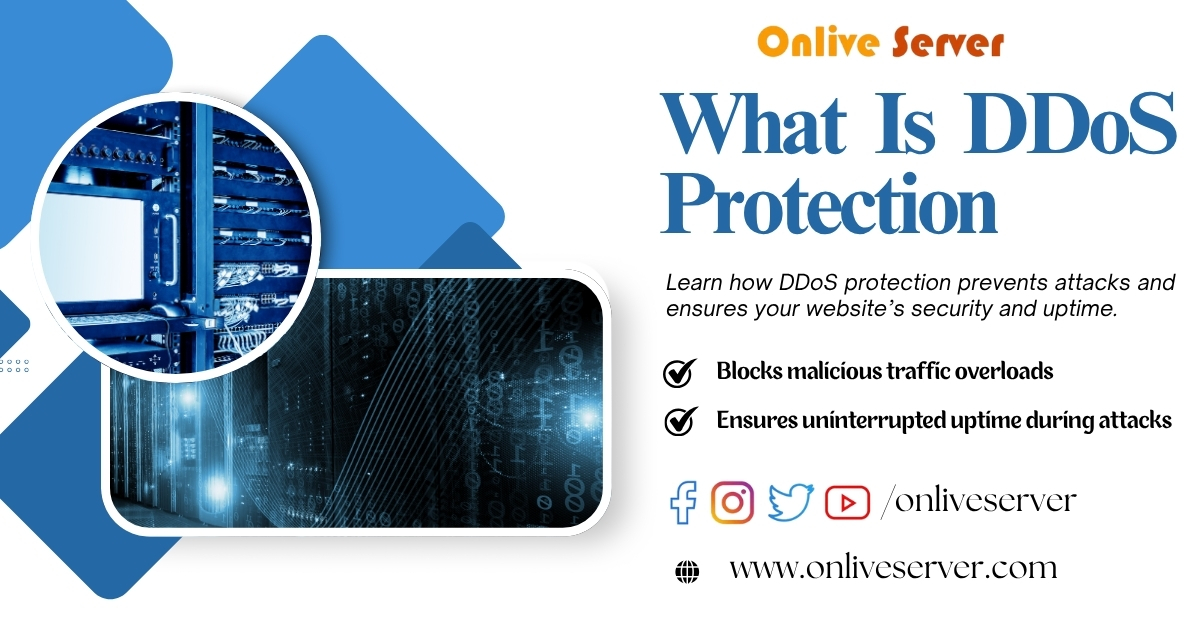
Online services are often disrupted by Distribute Denial of Service (DDoS) attacks which are among the most common and dangerous cyberattacks. A DDoS attack sends so much traffic to a target’s server, network or service that it becomes unavailable to genuine users. Usually, cybercriminals use a network of infected computers (called a botnet) to send a lot of data to the server, overloading it and making it unable to respond to regular requests.
DDoS protection involves spotting, reducing and stopping the harmful traffic before it does any damage. DDoS protection measures ensure that services remain available, so users are not bothere by the attacks. Having a strong DDoS protection plan is necessary for businesses and organizations to keep their systems running and avoid the high costs and damage to their reputation caused by downtime.
Understanding DDoS Attacks
A DDoS attack sends a huge amount of traffic to a network or service, making it hard for real users to use the service. The attacker uses a botnet which is a group of infected computers, to launch the attack. If a DDoS attack happens, the target’s server resources or bandwidth may use up which can result in services being unavailable.
It is hard to stop DDoS attacks, since the traffic comes from many different, spread-out sources which makes it challenging to tell the difference between good and bad traffic. Usually, the attackers hide the purpose of their attack and can modify their approach to avoid being stop by defenses. Any service online such as websites, e-commerce, cloud applications or online gaming, can targete by DDoS attacks.
Definition and Basic Concepts
In a DDoS attack, many systems or computers are use to send a lot of traffic which aims to use up the target’s resources. The purpose of this attack is to prevent an online service from working by sending it requests from thousands or millions of different IP addresses all at once.
Basically, DDoS attacks are meant to disrupt services, making websites, applications or networks unavailable. In contrast to usual cyberattacks which target data theft or malware spread, DDoS attacks are design to make websites or services unavailable by sending too much traffic.
Common Types of DDoS Attacks
There are several different types of DDoS attacks, each targeting specific vulnerabilities in a network or service:
Volume-Based Attacks: These attacks aim to consume all available bandwidth between the target and the internet. The most common types of volume-based DDoS attacks are UDP floods, ICMP floods, and DNS amplification attacks. These attacks are measured in bits per second (bps).
Protocol Attacks: These attacks target the protocols that manage communication between servers and clients. Examples include SYN floods, Ping of Death, and Smurf DDoS attacks. These attacks usually exploit weaknesses in network layer protocols and are measure in packets per second.
Application Layer Attacks: These attacks target the application layer of the OSI model, which is responsible for delivering services such as HTTP, DNS, or FTP. Common application layer attacks include HTTP floods and slow Loris attacks. These are typically more difficult to detect because they mimic legitimate user traffic, and they are measure in requests per second.
What Is DDoS Protection: A Comprehensive Overview
DDoS protection helps protect businesses, websites and online services from the effects of DDoS attacks. Because cyber threats are always changing, DDoS protection systems now focus on detecting them early, filtering traffic intelligently and dealing with attacks automatically.
DDoS protection keeps out harmful traffic and lets genuine traffic reach the target. A lot of protection systems combine on-premises, cloud and hybrid solutions. Ways to protect against DDoS attacks include filtering traffic, limiting the rate of requests, blacklisting certain IP addresses and using content delivery networks (CDNs) or Web Application Firewalls (WAFs).
A strong DDoS protection system should constantly monitor in real time, detect attacks automatically and respond flexibly to attacks of any size or complexity. Also, a failover system can maintain service even if an attack continues for a long period.
Core Components of DDoS Protection
Traffic Monitoring: Continuous traffic analysis is essential to identify unusual patterns or spikes that may indicate a DDoS attack. By monitoring incoming traffic, DDoS protection systems can quickly detect and respond to an attack before it disrupts services.
Traffic Filtering: Filtering involves blocking or redirecting malicious traffic while allowing legitimate traffic to reach its destination. Filters can be based on characteristics such as IP addresses, request frequency, or specific packet signatures.
Rate Limiting: Rate limiting involves restricting the number of requests a user or IP address can make within a specified time frame. This helps prevent overwhelming a server with excessive requests during an attack.
Redundancy and Failover Mechanisms: These systems ensure that traffic can be rerouted to backup systems or data centers if the primary server becomes overwhelmed or unavailable due to a DDoS attack.
How DDoS Protection Systems Work
DDoS protection systems identify and check traffic patterns and use set rules or machine learning to tell apart good traffic from bad traffic. If an attack is identified, the system responds by blocking bad traffic, redirecting requests or limiting how much traffic comes in.
Certain systems rely on IP reputation scoring and DPI to locate and block traffic from suspicious IPs or botnets. The purpose is to minimize the effects of the attack but not interrupt the regular use of the system by genuine users.
DDoS protection systems can be set up at any level of the network, starting from the application layer and going to the physical network layer. The type of solution—on-premises, cloud-base or hybrid—is chosen base on what the business requires.
The Growing Threat Landscape of DDoS Attacks
DDoS attacks have become more common, advanced and large in the past few years. Now that more devices are connect to the internet and the Internet of Things is growing, attackers can use many more ways to carry out DDoS attacks.
The numbers indicate that DDoS attacks are growing in size and also in the types used. Attackers are now using different methods to avoid being notice such as using attacks that mix volume, protocol and application methods. For this reason, companies are now more vulnerable to risks which can lead to major downtime, financial losses and harm to their reputation.
Recent findings show that DDoS attacks are now being aim at specific industries such as e-commerce, online gaming and financial institutions which depend on being online.
Recent Statistics and Trends
Cybercriminals are expect to keep developing new ways to attack and use stronger botnets, so this trend should continue. While companies are adding DDoS mitigation measures, a lot of them still do not fully recognize how serious and complex these threats can be.
Industries Most Targeted by DDoS Attacks
Certain industries are more likely to be targeted by DDoS attacks due to the critical nature of their online services. These industries include:
- E-commerce: Online retailers are prime targets due to the potential for financial loss during downtime.
- Gaming: Online gaming platforms are often targeted by DDoS attacks to disrupt gameplay and demand ransoms.
- Financial Institutions: Banks and payment processors face attacks aiming to disrupt services and steal data.
- Healthcare: Hospitals and medical services are attack to steal sensitive data or cause operational disruptions.
- Government Agencies: Government websites and services are often attacked as part of politically motivated campaigns.
Distinguishing DDoS from Other Network Issues
We must be able to tell DDoS attacks apart from other problems in the network such as hardware breakdowns, software issues or too many users causing congestion. DDoS attacks are usually marke by a quick rise in traffic from many different sources, unlike other network problems which build up over time.
Being able to tell the difference helps organizations choose the right countermeasures. For example, when the network is congested, it may need more bandwidth, but a DDoS attack requires more advanced solutions such as filtering traffic or limiting the rate.
Key DDoS Protection Technologies and Methods
Several technologies and methods are commonly use to prevent and mitigate DDoS attacks:
- Traffic Filtering and Scrubbing: This process involves routing traffic through a scrubbing center where malicious packets are filter out.
- Cloud-based DDoS Mitigation: Cloud providers offer massive scale and redundancy, which helps absorb large-scale DDoS attacks.
- Anycast Routing: Distributes traffic across multiple data centers, making it harder for attackers to target a single server.
- Web Application Firewalls (WAFs): Protects web applications from application layer attacks by filtering and monitoring HTTP traffic.
Traffic Filtering and Scrubbing
Traffic filtering and scrubbing are two key components in combating DDoS attacks. Analyzes incoming traffic for signs of malicious intent, while scrubbing cleanses the traffic by removing harmful elements. These processes ensure that only legitimate users access the services.
Benefits of On-Premises Protection
On-premises DDoS protection provides several benefits, including:
- Complete Control: Organizations have full control over their security infrastructure.
- Real-time Detection and Response: On-premises systems can provide immediate reaction to attacks without relying on third-party services.
- Customization: Tailored solutions to meet the specific needs of the organization.
OnliveServer DDoS Protection Solutions
OnliveServer provides reliable DDoS protection to help businesses defend against any type of attack. Thanks to its advanced setup and ongoing monitoring, OnliveServer keeps clients’ services running through even the fiercest DDoS attacks. They use traffic filtering, rate limiting and real-time monitoring to ensure that clients are well protect.
OnliveServer Protection Infrastructure
OnliveServer DDoS protection system is design with several layers to catch any attacks that happen. High-speed connections and advanced filters are use in their data centers to stop DDoS attacks.
Key Features and Benefits
- Advanced Traffic Filtering: Identifies and blocks malicious traffic without affecting legitimate users.
- Real-Time Monitoring: Continuous surveillance to detect attacks at the earliest stage.
- Global Presence: OnliveServer distributed infrastructure ensures the best possible performance and attack mitigation.
Implementing Effective DDoS Protection Strategies
For strong DDoS protection, businesses need to use different methods such as checking traffic, automatic filtering and switching to backup systems. Being proactive, checking security regularly and using cloud services can help defend against DDoS attacks.
Conclusion
Any organization that uses online services for business should have DDoS protection. If companies use a combination of on-premises, cloud and hybrid solutions, they can better protect their systems from DDoS attacks. It is important to understand new threats and pick the right security tools to keep services running and protect the business.
